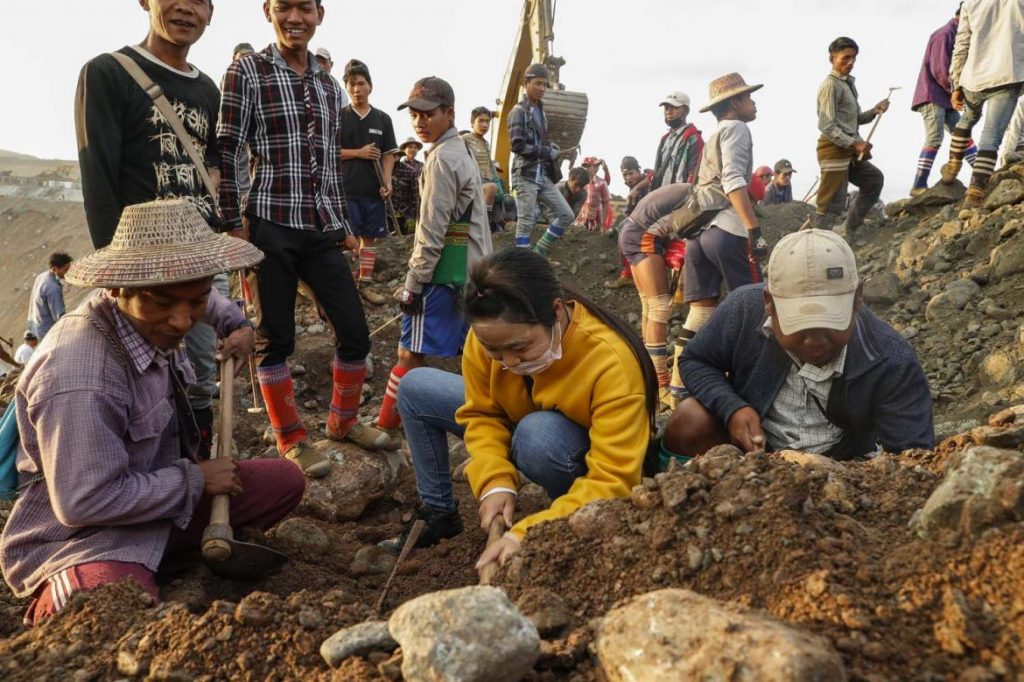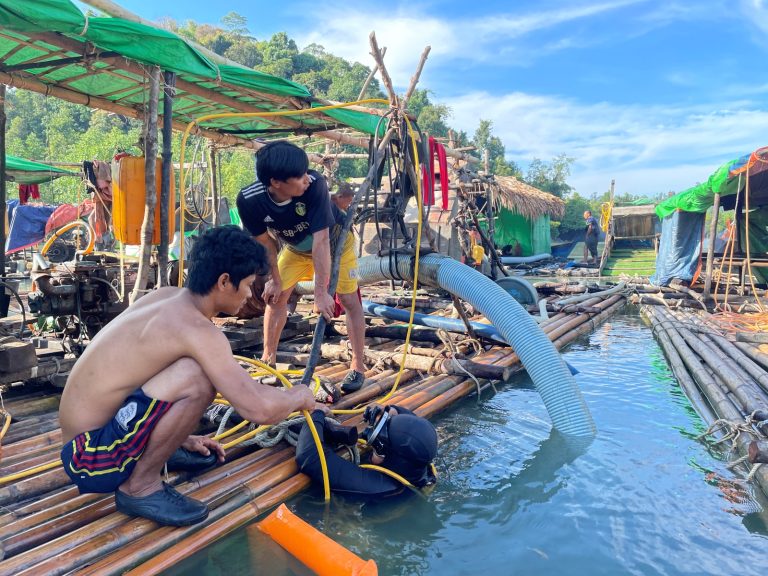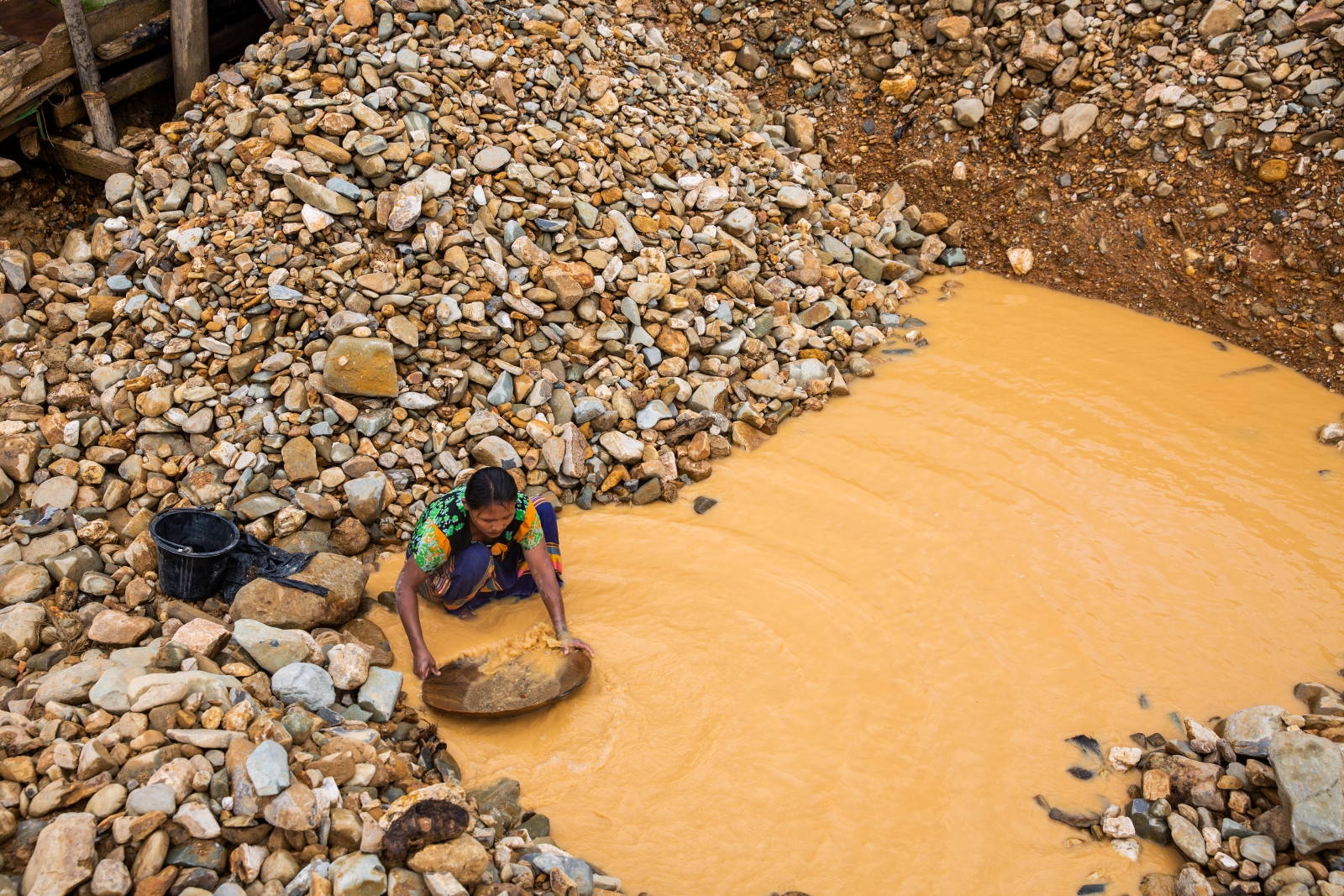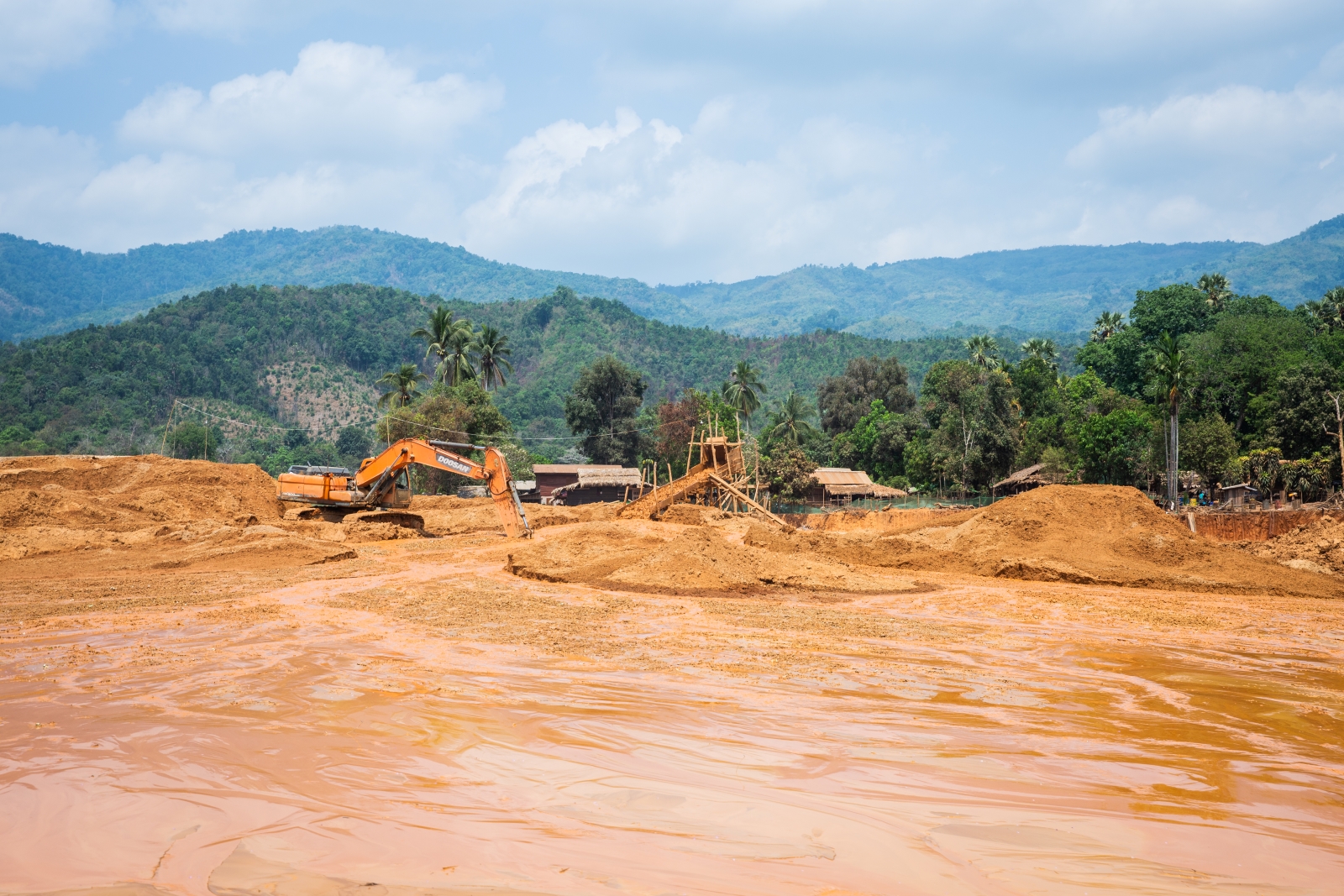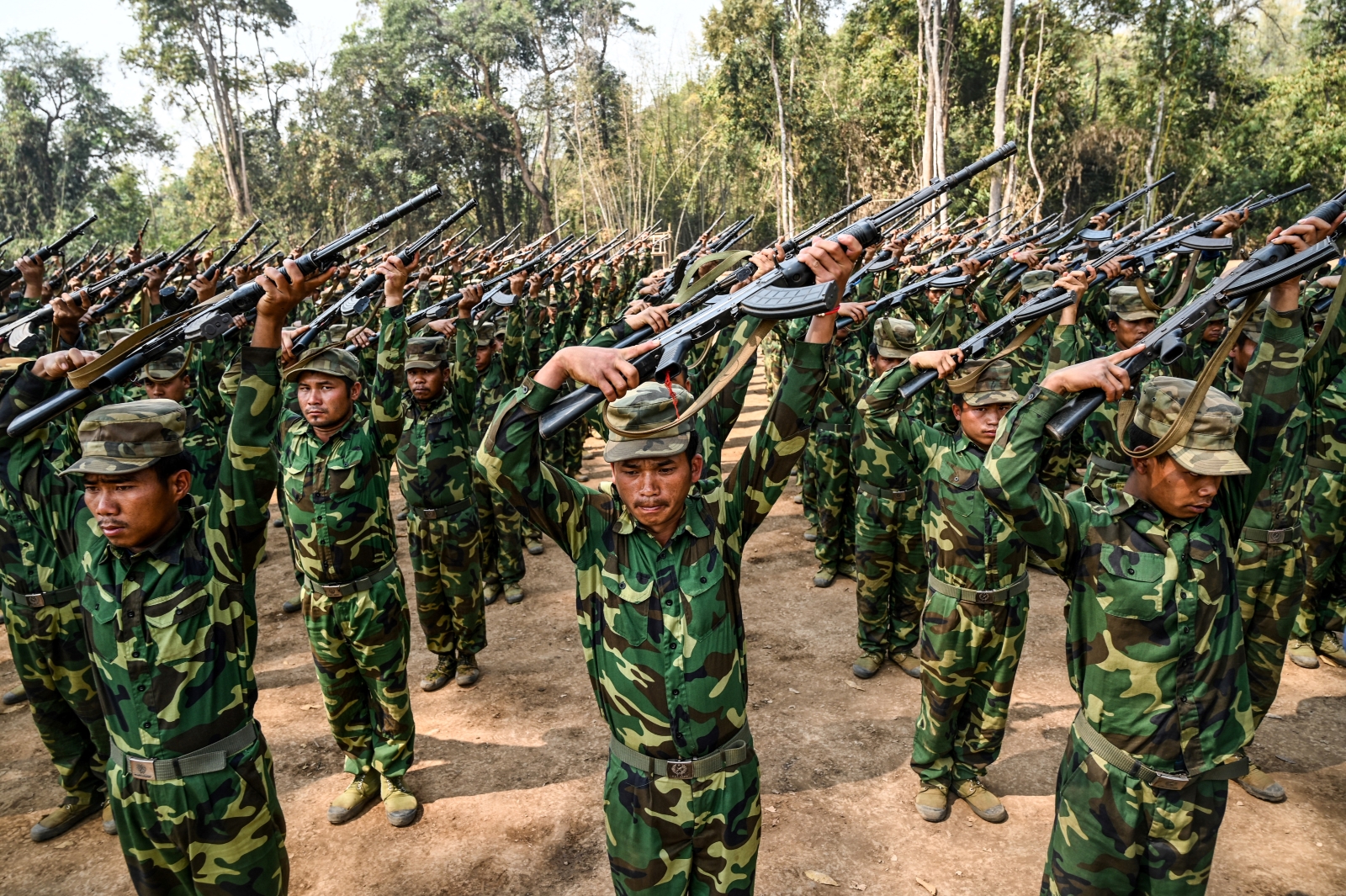Kachin’s jade industry is heavily dominated by men, but with the male workforce ground down by drug addiction, more and more women are taking up dangerous work at the mines.
Words & photos by NYEIN SU WAI KYAW SOE | FRONTIER
“I’M LOOKING for a stone that could change the lives of me and my family,” said a sweating Ma Myint Myint Htwe, her face smeared with thanaka, as she fossicked for jade beside dozens of men on a massive tailings mound in Kachin State’s Hpakant Township.
Myint Myint Htwe, 38, is originally from Kantbalu in Sagaing Region but has has lived for more than 10 years near the Hwekha mines at Hpakant.
ns-5-800.jpg

Ma Myint Myint Htwe, a freelance jade picker at the Hwekha mines in Hpakant, Kachin State. (Nyein Su Wai Kyaw Soe | Frontier)
Needing to feed two children, she decided to become a yemase thama, or freelance jade picker, a few months ago after her husband’s addiction to heroin left him incapable of working. Drug addiction blights the lives of many jade pickers at Hpakant, which produces jadeite of a quality that has long been prized in China, where it is known as “the stone of heaven”.
Support more independent journalism like this.Sign up to be a Frontier member.
Beyond the drug scourge, the working conditions at the mines are notoriously dangerous. The jade pickers are at constant risk of being engulfed by mine rubble if one of the towering tailings mounds collapses, as one did in November 2015, killing more than 100 people.
ns-101.jpg

Nyein Su Wai Kyaw Soe | Frontier
In 2018, the Myitkyina-based Humanity Institute and Kachin National Social Development Association estimated that about 500 people had been killed in landslides in Hpakant over the previous four years. Unstable tailings dams – disused pits filled with rainwater where companies illegally dump their waste – are another threat. In April 2019, 54 mine workers drowned in sludge after a tailings dam collapsed on a hillside above their heads.
“I don’t have any choice but to work among these men; I have to try my luck for my family,” said Myint Myint Htwe, one of the few women jade pickers among the thousands of men who scour the tailings mounds at Hpakant in the hope of finding a stone that will deliver them from poverty.
ns-21-6-13.jpg

Women and men search for valuable stones in mining waste at the Hwekha jade mines in Hpakant. (Nyein Su Wai Kyaw Soe | Frontier)
Another is Myint Myint Htwe’s friend, Ma Sheh Paing, aka Ma Chin Ma, 40, who is originally from the town of Kalay in Sagaing Region, bordering Chin State. Since 2010, she has worked as a yemase thama alongside her husband, with whom she has three children.
“At first, some of the men teased me,” Chin Ma told Frontier. “My husband warned me, saying, ‘They will not understand you and think you are a drug addict or something; don’t come along with me’. But I don’t care what they think; I just want to know how to find jade,” she said.
In her first year of scrambling over the tailings, Ma Chin found her first valuable stone. She showed it to her husband and after a quick evaluation, he said, “We won’t have trouble selling this stone, honey,” she recalled.
ns-30.jpg

Ma Sheh Paing, a freelance jade picker in Hwekha, Hpakant. (Nyein Su Wai Kyaw Soe | Frontier)
“I was so happy. I sold it for K1.5 million (US$1,015) and gave some of the money to my parents,” said Ma Chin, who bristles at the discriminatory attitudes faced by women jade pickers.
“Finding valuable stones is all about luck and there is no reason why both men and women can’t do it; it’s just luck,” she said. “Here, it’s like the men have to work as jade pickers or in the mines and women have to work in the kitchen, but I don’t like that. There’s no reason why we can’t work beside men; we can both be lucky. We have two hands and two legs, the same as men, and we can find jade, too.”
ns-17.jpg

Freelance jade pickers sift through mining waste in Hwekha. (Nyein Su Wai Kyaw Soe | Frontier)
About 90 percent of the world’s jade is mined in either Kachin or neighbouring Sagaing Region. Hundreds of companies mine for jade, either as private entities or in joint ventures with state-owned Myanma Gems Enterprise. Hundreds of thousands of people from throughout the country have travelled to Hpakant and elsewhere in Kachin to work in the mines or as freelance pickers, and they are met by a ready supply of drugs.
In late 2017, the five companies working at the Nam Shae jade mines in Mohnyin Township, just south of Hpakant, grew exasperated at the high rates of drug addiction among men and so began to hire women in their place.
ns-10.jpg

Nyein Su Wai Kyaw Soe | Frontier
“Addicts will do anything to get money to buy drugs, including stealing jade, so we thought we should begin hiring women because they are more trustworthy and more reliable,” said Ko Han Shwe, a former mine manager at Nam Shae who now works as a freelance jade trader.
The decision resulted in many applications from women keen to make a living as mine workers. They were trained to identify different grades of jade and Han Shwe said they were enthusiastic students. Their basic salary starts at K120,000 a month, including meals and accommodation, and they receive a commission for any valuable stones they find, he said.
ns-400.jpg

Nyein Su Wai Kyaw Soe | Frontier
“The company also gives a monthly bonus to the worker who finds the most valuable stones each month, as an incentive to work hard and a deterrent against stealing,” Han Shwe added, while refusing to name the company he worked for.
The salary is much higher than the basic rate paid to workers outside the mining industry in Mohnyin Township.
ns-34.jpg

Raw jade is sold at a night market in Hwekha. (Nyein Su Wai Kyaw Soe | Frontier)
A shopkeeper in Mohnyin town said the most he could afford to pay his two young female employees was K70,000 a month – a rate that’s below the national minimum wage, currently pegged at K4,800 per day, as a monthly aggregate, but which Mohnyin residents described as a typical wage for shop staff in the town.
The shopkeeper said that, given the option, “They will go and work for a mining company, for sure.”


